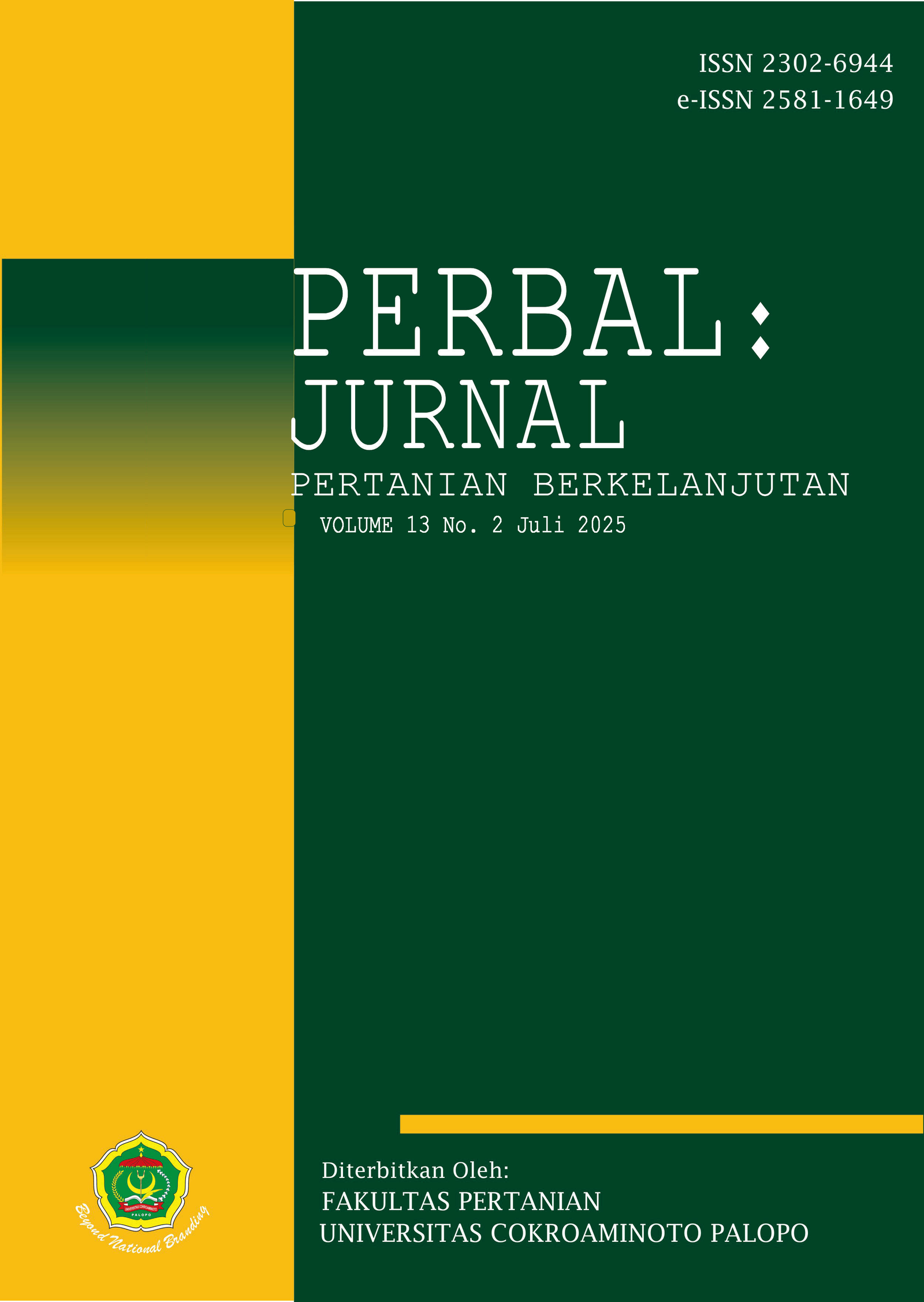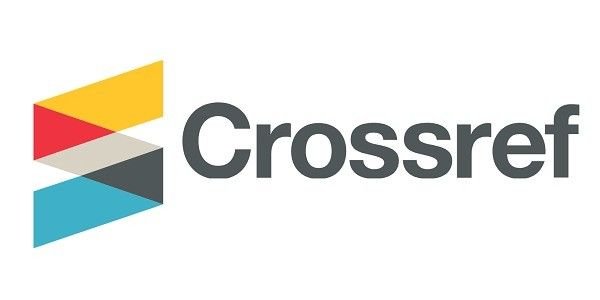Upaya Peningkatan Hasil Panen Tanaman Brokoli (Brassica oleracea L.) dengan Pemberian Mikroorganisme Lokal (MOL) Kulit Pisang
Initiatives to Enhance the Yield of Broccoli (Brassica oleracea L.) with Giving Banana Peel Local Microorganism
DOI:
https://doi.org/10.30605/perbal.v13i2.6217Keywords:
Brokoli, limbah, MOL, organik, sayuranAbstract
Kulit pisang, salah satu hasil samping pertanian yang sering terbuang, memiliki potensi sebagai bahan baku untuk produksi mikroorganisme lokal (MOL) yang dapat meningkatkan pertumbuhan dan perkembangan tanaman. Komposisi nutrisi MOL berbeda berdasarkan bahan sumbernya, sehingga memerlukan penentuan konsentrasi yang tepat untuk tanaman tertentu. Penelitian ini bertujuan untuk memastikan konsentrasi MOL kulit pisang yang optimal untuk meningkatkan perkembangan dan produktivitas brokoli (Brassica oleracea L.). Percobaan dilakukan dari bulan Juni sampai Oktober 2024 di Lalong-Luwu, Provinsi Sulawesi Selatan. Rancangan Acak Kelompok (RAK) digunakan, yang terdiri dari enam perlakuan: k0 (0 ml = kontrol), k1 (20 ml), k2 (40 ml), k3 (60 ml), k4 (80 ml), dan k5 (100 ml), masing-masing diduplikasi tiga kali dengan tiga tanaman per unit percobaan. Data dianalisis dengan Analisis Varians (ANOVA), kemudian diikuti oleh uji Beda Nyata Jujur (BNJ). Aplikasi MOL kulit pisang sangat mempengaruhi tinggi tanaman, jumlah daun, hari berbunga, dan berat bunga. Konsentrasi maksimum (100 ml) menghasilkan hasil optimal, dengan tinggi tanaman 30,43 cm, rata-rata 19,23 daun per tanaman, pembungaan terjadi pada 88,44 hari pasca tanam, dan berat bunga 319,53 g.
Banana peel, a frequently discarded agricultural by product, possesses potential as a raw material for the production of local microorganisms that can promote plant growth and development. The nutrient composition of local microorganisms differs based on the source material, requiring the determination of appropriate concentrations for particular crops. This study sought to ascertain the optimal concentration of banana peel of local microorganisms for enhancing the development and productivity of broccoli (Brassica oleracea L.). The experiment was carried out from June to October 2024 in Lalong-Luwu, South Sulawesi Province. A Randomised Block Design (RBD) was utilised, comprising six treatments: k0 (0 ml=control), k1 (20 ml), k2 (40 ml), k3 (60 ml), k4 (80 ml), and k5 (100 ml), each duplicated thrice with three plants per experimental unit. Data were analysed with Analysis of Variance (ANOVA), subsequently followed by the Honestly Significant Difference (HSD) test. The application of banana peel local microorganisms greatly influenced plant height, leaf count, days to flowering, and flower weight. The maximum concentration (100 ml) yielded optimal outcomes, with a plant height of 30.43 cm, an average of 19.23 leaves per plant, flowering occurring at 88.44 days post-planting, and a flower weight of 319.53 g.
Downloads
References
Akbari, W.A., Fitrianingsih, Y. & Jati, D.R. (2015). Pemanfaatan limbah kulit pisang dan tanaman Mucuna bracteata sebagai pupuk kompos. Jurnal Teknologi Lingkungan Lahan Basah, 3(1), 1-10. DOI: https://doi.org/10.26418/jtllb.v3i1.11424
Alex, S. (2015). Sukses Mengelolah Sampah Organik. Pustaka Baru Press. Yogyakarta.
Aulia, D.D., Nasrul, M. & Setyawati, H. (2022). Pengaruh pupuk organik cair (POC) dengan menggunakan bioaktivator MOL terhadap pertumbuhan dan produksi tanaman andewi (Cichorium endevi L.). Atmosphere, 3(2), 18-23. DOI: https://doi.org/10.36040/atmosphere.v3i2.6037
Badan Pusat Statistik (2020). Laju Pertumbuhan Produksi Jawa Barat.
Damanik, M.M.B., Hasibuan, B.E., Fauzi, Sarifuddin & Hanum, H. (2011). Kesuburan Tanah dan Pemupukan. USU Press. Medan.
Dangi, S.P., Aryal, K., Soti, P., Magar, Bhattarai, S., Shrestha, D., Gyawali, S. & Basnet, M. (2019). Study on effect of phosphorus on growth and flowering of marigold (Tagetes erecta). JOJ Wildl Biodivers, 1(5): 555571.
Gad, N., & M. R.Abd El-Moez. (2011). Broccoli growth, yield qualily as affeceted by Cobalt nutrition. Agriculture and Biology Journal of North America, 2(2), 226-231. DOI: https://doi.org/10.5251/abjna.2011.2.2.226.231
Hardjowigeno, S. (2003). Klasifikasi Tanah dan Pedogenesis. Akademika Pressindo. Jakarta.
Harjadi, S.S. (2002). Pengantar Agronomi. Gramedia. Jakarta.
Ibrahim, Y., & Tanaiyo, R. (2018). Respon tanaman sawi (Brasicca juncea L.) terhadap pemberian pupuk organik cair (POC) kulit pisang dan bonggol pisang. Agropolitan, 5(1), 63-69.
Kaleka, N. (2017). Budidaya Brokoli. Bisa Publishing. Surakarta.
Li, M., Zhu, Y., Li, S., Zhang, W., Yin, C. & Lin, Y. (2022). Regulation of phytohormones on the growth and development of plant root hair. Frontiers in Plant Science, 13,1-13. DOI: https://doi.org/10.3389/fpls.2022.865302
Nasution, F.J., Mawarni, l., & Meiriani, M. (2014). Aplikasi pupuk organik dan cair dari kulit pisang kepok untuk pertumbuhan dan produksi sawi (Brassica juncea L). Jurnal Agroteknologi Universitas Sumatera Utara, 2(3), 1029-1037.
Sitompul, H.S., Maulina, I., Situmorang, I. (2023). Analisis kandungan unsur hara pupuk organik cair dari limbah pisang (Musa paradisiaca). Jurnal Pendidikan Sains dan Komputer, 3(2). DOI: https://doi.org/10.47709/jpsk.v3i02.3288
Soepriyanto, S., Sulistyawati, Purnamasari, R.T. (2021). Pengaruh pemberian berbagai jenis pupuk nitrogen terhadap jumlah klorofil daun kacang tanah (Arachis hypogaea L.) Jurnal Agroteknologi Merdeka Pasuruan, 5(1), 23-31.
Sriharti & Salim, T. (2008) Pemanfaatan Limbah Pisang untuk Pembuatan Kompos Menggunakan Komposer Rorary Drum. LIPI. hal : 68.
Sulistiani, D., Ardian & Ariani, E. (2018). Pemberian POC kulit pisang pada medium arang sekam terhadap pertumbuhan dan hasil tanaman kacang hijau (Vigna radiata) secara hidroponik. Jurnal Online Mahasiswa Fakultas Pertanian. Universitas Riau. 5(2), 84-91.
Susila, A.D. (2006). Panduan Budidaya Tanaman Sayuran. Agronomi dan Hortikultura, Fakultas Pertanian IPB.
Suyamto, Zubachtirodin, Pabbage, M.S. & Saenong, S. (2006). Pengelolaan Tanaman Terpadu (PTT). Badan Penelitian dan Pengembangan Pertanian. Bogor.
Tuapattinaya, P.M.J., & Tutupoly, F. (2014). Pemberian pupuk kulit pisang raja (Musa sapientum) terhadap pertumbuhan dan produksi tanaman cabai rawit (Capsicum frutescens L.). Biopendix, 1(1), 13-21. DOI: https://doi.org/10.30598/biopendixvol1issue1page13-21
Wulandari, C.G.M, Muhartini, S. & Trisnowati, S. (2012). Pengaruh air cucian beras merah dan beras putih terhadap pertumbuhan dan hasil selada (Lactuca sativa L.). Vegetalika, 1(2), 24–35. DOI: https://doi.org/10.56071/oryza.v8i2.627
Yahya, S., Indrawati, Syam, H., & Abidin, Z. (2023). Pemberdayaan ekonomi masyarakat melalui pembuatan pupuk organik dan budidaya sayur organik. Jurnal Pengabdian kepada Masyarakat, 3(2), 289–295. DOI: https://doi.org/10.46964/etam.v3i2.536
Downloads
Published
Issue
Section
License
Copyright (c) 2025 Naima Haruna, Rahmi Azizah Mudaffar, Kesia Kesia, Paradilla Ilyas Mattola, Rosnina Rosnina

This work is licensed under a Creative Commons Attribution 4.0 International License.
In submitting the manuscript to the journal, the authors certify that:
- They are authorized by their co-authors to enter into these arrangements.
- The work described has not been formally published before, except in the form of an abstract or as part of a published lecture, review, thesis, or overlay journal.
- That it is not under consideration for publication elsewhere,
- That its publication has been approved by all the author(s) and by the responsible authorities – tacitly or explicitly – of the institutes where the work has been carried out.
- They secure the right to reproduce any material that has already been published or copyrighted elsewhere.
- They agree to the following license and copyright agreement.
License and Copyright Agreement
Authors who publish with Onoma Journal: Education, Languages??, and Literature agree to the following terms:
- Authors retain copyright and grant the journal right of first publication with the work simultaneously licensed under Creative Commons Attribution License (CC BY 4.0) that allows others to share the work with an acknowledgment of the work's authorship and initial publication in this journal.
- Authors are able to enter into separate, additional contractual arrangements for the non-exclusive distribution of the journal's published version of the work (e.g., post it to an institutional repository or publish it in a book), with an acknowledgment of its initial publication in this journal.
- Authors are permitted and encouraged to post their work online (e.g., in institutional repositories or on their website) prior to and during the submission process, as it can lead to productive exchanges, as well as earlier and greater citation of published work.














